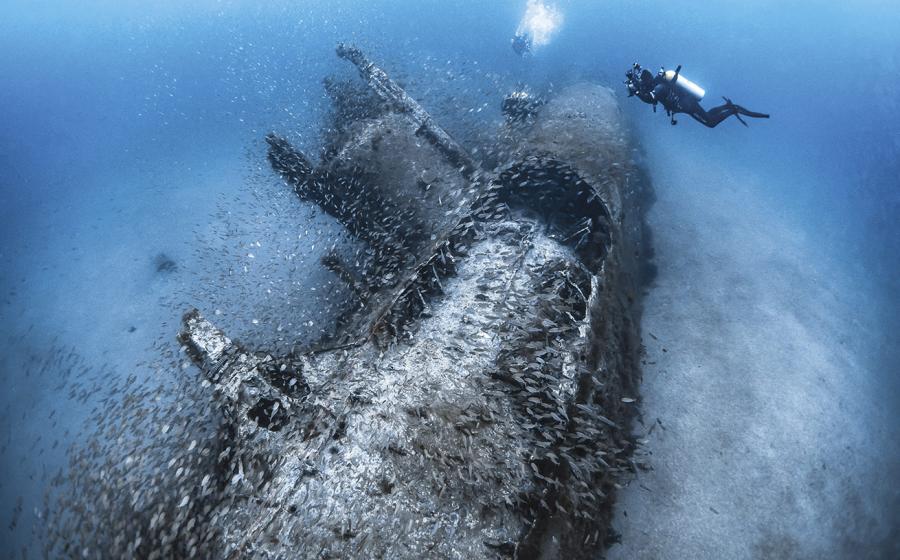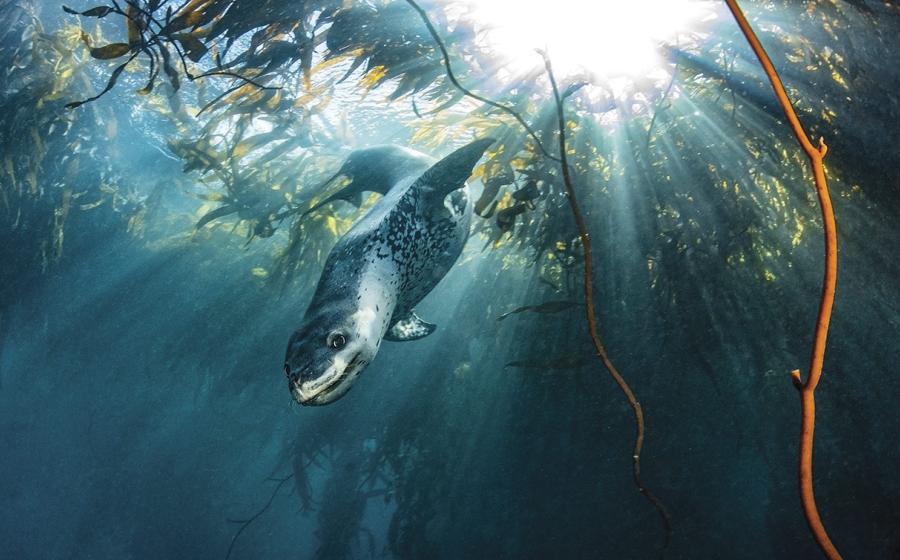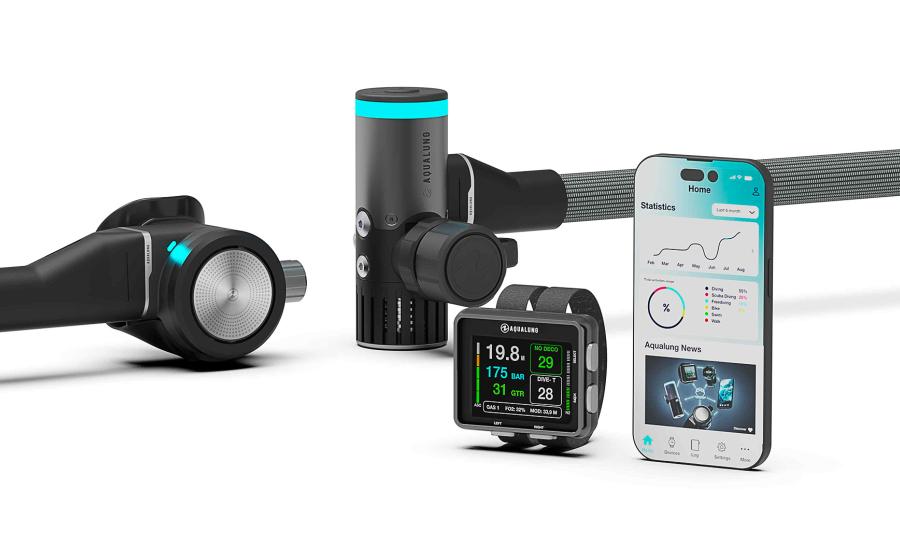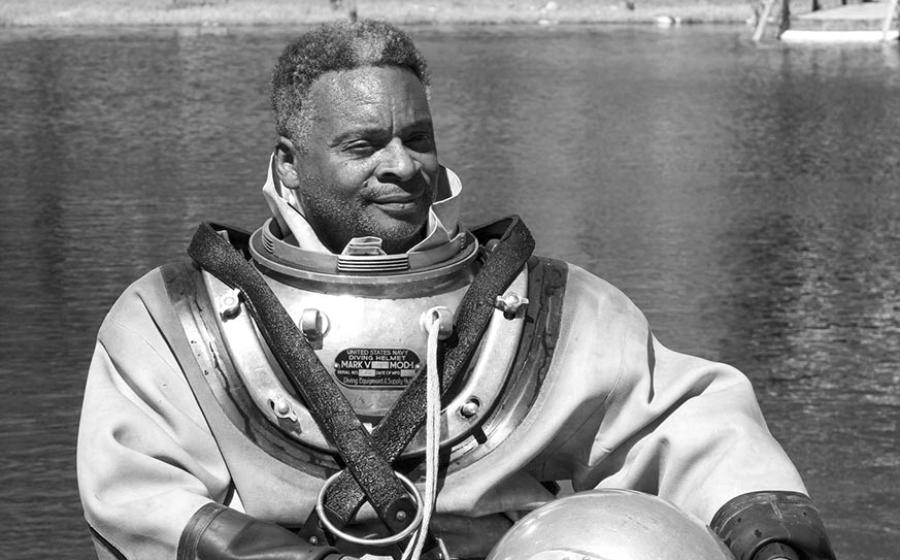Digital Still Photography: 10 Tips
||
|---|
|  |
|
With over two decades experience shooting underwater stills with slide film, I'm a novice with digital media. Yet I know it's a technology I'll be forced to embrace one day. Pixels will inevitably be part of any pro shooter's arsenal, if for no other reason than the compelling advantages digital imaging offers:
-
You see what you shoot, right away, while still under water.
-
You can delete the shots you don't like and save the ones you do.
-
Images saved are already in digital form, no scanning necessary.
-
Digital images are perfect for e-mailing, printing on a home computer, transmitting online or burning to CDs for clients.
-
The savings on film and processing alone are worth the cost of admission to the digital world.
For these and other reasons, anyone who takes underwater photographs should consider the digital alternative.
The Digital Red Sea
||
|---|
|  |
|
On a recent assignment to the Red Sea, I packed a Tetra housing and an Olympus C-3040 digital camera, courtesy of Light & Motion. What follows isn't a review of these products, but my first impressions of the challenges and rewards of digital imaging in the real world of underwater photography.
Size: David vs. Goliath
I'm used to transporting my location camera systems in a heavy backpack and a wheeled camera case for carry-on, as well as a Pelican 1620 hard case that I check through. This is the absolute minimal baggage I require to carry a couple of Nikonos RS and V bodies, spare lenses, Seacam housing and ports, strobes, arms and a topside camera system?not to mention the 100 rolls of film I have to hand carry because a bomb detection device will likely ruin them with X-rays if sent via checked luggage.
Excess baggage and backaches have simply been a part of my profession. Now the folks at Light & Motion have sent me a camera that can shoot above and below the surface in a housing that fits in the palm of my hand. Already they have my attention.
Setting Up: 4 Field Tips
||
|---|
|  |
|
If you can capture images on film, you can capture images on digital, but there are techniques, advantages and limitations that differentiate the two media and require a learning curve and careful reading of the instruction manual. The manual from Light & Motion contains a few semi-obvious suggestions that really make underwater digital easier.
-
Use a 128mb SmartMedia card. The more images per dive the better. With the standard 16mb card, I could get one image at the very highest resolution (tiff) or six at "super high quality" (SHQ). Even the 64mb card yields 27 photos at SHQ, a reasonable number per dive, especially when you can delete the bad ones while under water. Lower-quality settings would give more images per card, but unfortunately at unusable resolution for my demands. The higher-capacity card makes perfect sense for any situation where quick card changes or downloads are impossible (like under water).
-
Keep fresh batteries in the camera. Digital cameras use a lot of battery power, and you can't change the batteries under water. I used 1600 mAh Nickel Metal Hydride batteries and typically got two dives per charged set.
-
Customize camera features before putting it in the housing. This includes turning the camera flash off (other cameras and strobes may require different settings), setting the ISO to 100, the recording mode to SHQ, and the "Rec View" feature on so it will automatically display the photo just shot. This last feature is one of the most important advantages of digital, as it allows instant review of the photo just taken.
-
Shoot in the manual mode. TTL technology won't work with this housing, although both Ikelite and Sea & Sea have delivered strobe technology that will bring TTL to some digital applications.
In-Water: 5 Lessons
||
|---|
|  |
|
The Tetra system is so small and unobtrusive that I was able to clip it to a D-ring on my BC. When I finished off my film cameras, I would begin using the digital system. My first impressions:
-
The housing is very cool. All important functions are available via buttons and a dial. I liked the fact that the synch port is non-TTL conventional Nikonos. I could use my E-O wet connectors that I use on my other underwater cameras, and just plug in my strobe as necessary. Plus, there are wide-angle and macro accessory optics that are easy to mount. Light & Motion hit a home run on the housing execution.
-
You might need a corrected mask to use this camera. I had a very difficult time reading the shutter speed and aperture readout in the camera LCD panel. Granted, I wear reading glasses topside, but for my Nikonos cameras and LCD panels in my other housed cameras, this has not been a problem. But with this camera, the small, green type against a predominantly blue background while under water, often viewed in high ambient light, gave me problems. I'll need to mount a gauge-reading diopter in any mask when I use digital in the future. In addition, I often found myself tucking the camera under a coral head so I could get more shade to better read the LCD.
-
Absolute sharp focus is difficult to confirm. No matter how good your vision, I think there will be difficulty in seeing critical focus details on an LCD screen that is hardly larger than two side-by-side postage stamps. What looks good under water may look horrible when viewed at 8 by 10 inches on the computer screen, or even larger in print. It is possible to zoom (enlarge 3X) a saved image under water in the housing, so some sense of resolution can be gleaned. But this is after the fact and still approximate. I guess I'm a ground-glass kind of guy who likes to confirm focus through an SLR. (Note: The advanced digital cameras like the Nikon D1 series and the Canon D30 do offer the combination of through-the-lens viewing plus digital image capture, but those cameras are in a whole different price range, and the housings are just now beginning to become available.)
-
Digital lag can be a pain. There is a slight time delay between when you press the shutter button and when the image actually records to the chip. While it may only be a second or so, a fish can move quite a bit in that time. For sedentary macro subjects, that's no problem. And for wide-angle with models, it's not a real issue either. But for shots of frenetic marine life, it can be frustrating to find the decisive moment so elusive. In actual practice I found that the lag time was predictable, and I could learn to lead the action enough so that I was getting a high percentage of images with strong compositions.
-
Immediate image review is absolutely awesome. This is where digital will rule. Seeing the image instantaneously allows for exposure or compositional corrections right there, on the spot. Typically I would shoot a series, and if I wasn't sure I got the shot I wanted, I would do a quick in-camera review. I'd delete the bad ones and thereby gain more storage capacity on my SmartMedia card so I could shoot some more. I even entertained myself while doing my safety stops by reviewing the digital shots captured on the dive.
AprA?s Dive: You're Cool
While the emulsion shooters were gathered around the light table examining analog images with a loupe, I found myself editing my digital images on my laptop. It is necessary to get the saved photos off the SmartMedia to gain capacity to shoot again, and the laptop is the logical repository. Other storage options include the Digital Wallet from [email protected], which can store up to 20GB of data, and Iomega's Fotoshow which saves directly to a Zip disk and can connect to a television to view images or present a slide show.
Bottom Line
||
|---|
|  |
|
I feel the Tetra housing and the Olympus C-3040 provide a wonderful entr?to digital imaging. The potential resolution is not high enough for my professional needs, nor is the angle of view wide enough, even with the available wide-angle accessory optic. Plus, there are questions as to the archival stability of digital media and which storage format will rule over the next decades.
But for many consumer and hobbyist applications, this is a wonderful tool. If I were just beginning to shoot under water, I'd look long and hard at digital before making the commitment to film. For a film dinosaur like me, that's a big admission. The technology is here already, and will only get better.
 With over two decades experience shooting underwater stills with slide film, I'm a novice with digital media. Yet I know it's a technology I'll be forced to embrace one day. Pixels will inevitably be part of any pro shooter's arsenal, if for no other reason than the compelling advantages digital imaging offers:
With over two decades experience shooting underwater stills with slide film, I'm a novice with digital media. Yet I know it's a technology I'll be forced to embrace one day. Pixels will inevitably be part of any pro shooter's arsenal, if for no other reason than the compelling advantages digital imaging offers:
You see what you shoot, right away, while still under water.
You can delete the shots you don't like and save the ones you do.
Images saved are already in digital form, no scanning necessary.
Digital images are perfect for e-mailing, printing on a home computer, transmitting online or burning to CDs for clients.
The savings on film and processing alone are worth the cost of admission to the digital world.
For these and other reasons, anyone who takes underwater photographs should consider the digital alternative.
The Digital Red Sea
 On a recent assignment to the Red Sea, I packed a Tetra housing and an Olympus C-3040 digital camera, courtesy of Light & Motion. What follows isn't a review of these products, but my first impressions of the challenges and rewards of digital imaging in the real world of underwater photography.
On a recent assignment to the Red Sea, I packed a Tetra housing and an Olympus C-3040 digital camera, courtesy of Light & Motion. What follows isn't a review of these products, but my first impressions of the challenges and rewards of digital imaging in the real world of underwater photography.
Size: David vs. Goliath
I'm used to transporting my location camera systems in a heavy backpack and a wheeled camera case for carry-on, as well as a Pelican 1620 hard case that I check through. This is the absolute minimal baggage I require to carry a couple of Nikonos RS and V bodies, spare lenses, Seacam housing and ports, strobes, arms and a topside camera system?not to mention the 100 rolls of film I have to hand carry because a bomb detection device will likely ruin them with X-rays if sent via checked luggage.
Excess baggage and backaches have simply been a part of my profession. Now the folks at Light & Motion have sent me a camera that can shoot above and below the surface in a housing that fits in the palm of my hand. Already they have my attention.
Setting Up: 4 Field Tips
 If you can capture images on film, you can capture images on digital, but there are techniques, advantages and limitations that differentiate the two media and require a learning curve and careful reading of the instruction manual. The manual from Light & Motion contains a few semi-obvious suggestions that really make underwater digital easier.
If you can capture images on film, you can capture images on digital, but there are techniques, advantages and limitations that differentiate the two media and require a learning curve and careful reading of the instruction manual. The manual from Light & Motion contains a few semi-obvious suggestions that really make underwater digital easier.
Use a 128mb SmartMedia card. The more images per dive the better. With the standard 16mb card, I could get one image at the very highest resolution (tiff) or six at "super high quality" (SHQ). Even the 64mb card yields 27 photos at SHQ, a reasonable number per dive, especially when you can delete the bad ones while under water. Lower-quality settings would give more images per card, but unfortunately at unusable resolution for my demands. The higher-capacity card makes perfect sense for any situation where quick card changes or downloads are impossible (like under water).
Keep fresh batteries in the camera. Digital cameras use a lot of battery power, and you can't change the batteries under water. I used 1600 mAh Nickel Metal Hydride batteries and typically got two dives per charged set.
Customize camera features before putting it in the housing. This includes turning the camera flash off (other cameras and strobes may require different settings), setting the ISO to 100, the recording mode to SHQ, and the "Rec View" feature on so it will automatically display the photo just shot. This last feature is one of the most important advantages of digital, as it allows instant review of the photo just taken.
Shoot in the manual mode. TTL technology won't work with this housing, although both Ikelite and Sea & Sea have delivered strobe technology that will bring TTL to some digital applications.
In-Water: 5 Lessons
 The Tetra system is so small and unobtrusive that I was able to clip it to a D-ring on my BC. When I finished off my film cameras, I would begin using the digital system. My first impressions:
The Tetra system is so small and unobtrusive that I was able to clip it to a D-ring on my BC. When I finished off my film cameras, I would begin using the digital system. My first impressions:
The housing is very cool. All important functions are available via buttons and a dial. I liked the fact that the synch port is non-TTL conventional Nikonos. I could use my E-O wet connectors that I use on my other underwater cameras, and just plug in my strobe as necessary. Plus, there are wide-angle and macro accessory optics that are easy to mount. Light & Motion hit a home run on the housing execution.
You might need a corrected mask to use this camera. I had a very difficult time reading the shutter speed and aperture readout in the camera LCD panel. Granted, I wear reading glasses topside, but for my Nikonos cameras and LCD panels in my other housed cameras, this has not been a problem. But with this camera, the small, green type against a predominantly blue background while under water, often viewed in high ambient light, gave me problems. I'll need to mount a gauge-reading diopter in any mask when I use digital in the future. In addition, I often found myself tucking the camera under a coral head so I could get more shade to better read the LCD.
Absolute sharp focus is difficult to confirm. No matter how good your vision, I think there will be difficulty in seeing critical focus details on an LCD screen that is hardly larger than two side-by-side postage stamps. What looks good under water may look horrible when viewed at 8 by 10 inches on the computer screen, or even larger in print. It is possible to zoom (enlarge 3X) a saved image under water in the housing, so some sense of resolution can be gleaned. But this is after the fact and still approximate. I guess I'm a ground-glass kind of guy who likes to confirm focus through an SLR. (Note: The advanced digital cameras like the Nikon D1 series and the Canon D30 do offer the combination of through-the-lens viewing plus digital image capture, but those cameras are in a whole different price range, and the housings are just now beginning to become available.)
Digital lag can be a pain. There is a slight time delay between when you press the shutter button and when the image actually records to the chip. While it may only be a second or so, a fish can move quite a bit in that time. For sedentary macro subjects, that's no problem. And for wide-angle with models, it's not a real issue either. But for shots of frenetic marine life, it can be frustrating to find the decisive moment so elusive. In actual practice I found that the lag time was predictable, and I could learn to lead the action enough so that I was getting a high percentage of images with strong compositions.
Immediate image review is absolutely awesome. This is where digital will rule. Seeing the image instantaneously allows for exposure or compositional corrections right there, on the spot. Typically I would shoot a series, and if I wasn't sure I got the shot I wanted, I would do a quick in-camera review. I'd delete the bad ones and thereby gain more storage capacity on my SmartMedia card so I could shoot some more. I even entertained myself while doing my safety stops by reviewing the digital shots captured on the dive.
AprA?s Dive: You're Cool
While the emulsion shooters were gathered around the light table examining analog images with a loupe, I found myself editing my digital images on my laptop. It is necessary to get the saved photos off the SmartMedia to gain capacity to shoot again, and the laptop is the logical repository. Other storage options include the Digital Wallet from [email protected], which can store up to 20GB of data, and Iomega's Fotoshow which saves directly to a Zip disk and can connect to a television to view images or present a slide show.
Bottom Line
 feel the Tetra housing and the Olympus C-3040 provide a wonderful entr?to digital imaging. The potential resolution is not high enough for my professional needs, nor is the angle of view wide enough, even with the available wide-angle accessory optic. Plus, there are questions as to the archival stability of digital media and which storage format will rule over the next decades.
feel the Tetra housing and the Olympus C-3040 provide a wonderful entr?to digital imaging. The potential resolution is not high enough for my professional needs, nor is the angle of view wide enough, even with the available wide-angle accessory optic. Plus, there are questions as to the archival stability of digital media and which storage format will rule over the next decades.
But for many consumer and hobbyist applications, this is a wonderful tool. If I were just beginning to shoot under water, I'd look long and hard at digital before making the commitment to film. For a film dinosaur like me, that's a big admission. The technology is here already, and will only get better.






